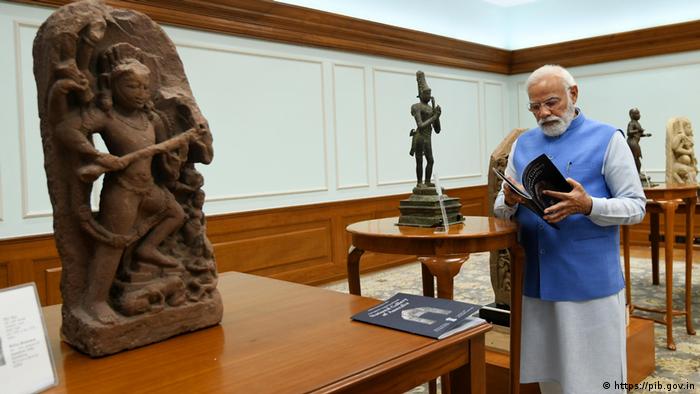As the conversation around looted artifacts gains prominence across the world, India's attempts to repatriate stolen heritage items are beginning to bear fruit.

Indian Prime Minister Narendra Modi inspected the artifacts repatriated from Australia in March
Indian Prime Minister Narendra Modi recently thanked Australia for returning 29 Indian-origin artifacts that hade been stripped from the South Asian country illegally. It's the latest in a string of ancient artifacts that have been returned to India.
The objects — including sculptures, paintings, photographs and a scroll — date back to the ninth century and were held by the National Gallery of Australia.
"I thank you for your initiative to return Indian antiquities and the antiquities sent by you include artifacts hundreds of years old and photos that were illegally taken out of Rajasthan, West Bengal, Gujarat, Himachal Pradesh and other Indian states," Modi told Australian Prime Minister Scott Morrison at the 2nd India-Australia Virtual Summit on March 21.
A catalog shared by the government showcased 12th-century Chola bronzes, 11th-12th century Jain sculptures from Rajasthan, 12th-13th century sandstone Goddess Mahisasuramardini from Gujarat, a number of 18th-19th century paintings, and early gelatin silver photographs.
Push to bring back heritage items
India has lost several significant national artifacts, first under British colonial rule and then through illegal smuggling activities. As the conversation around looted artifacts gains prominence across the world, its attempts to repatriate stolen heritage items are bearing fruit.
In September last year, Prime Minister Modi was credited with bringing back 157 Indian artifacts, which were handed to him during his visit to the United States, where he and US President Joe Biden expressed their commitment to strengthening efforts to combat theft, illicit trade and the trafficking of such objects.
While almost half of these artifacts were cultural, the other half were figurines linked to Hinduism, Buddhism and Jainism.
It's estimated that thousands of artworks are stolen from Indian temples each year and put on a thriving international antiquities market.
Where do the artifacts go?
Since coming to power in 2014, Modi has brought back Indian cultural items from trips to many countries, including Australia, Canada, Germany, Singapore, as well as the US.
"The return of these artifacts is a welcome move as they represent the cultural identity of India," Juhi Sadiya, assistant professor at the New Delhi-based National Museum Institute, told DW.
While the final destination of these items will be decided by the competent authorities within the government, Sadiya said that the museum was well equipped to provide the preventive conservation these objects required. This includes offering micro-climates with the right humidity, temperatures and light conditions to prevent any damage.
Anupam Sah, a leading art conservation-restoration practitioner, said that preventive conservation can be implemented even at novice institutions.
"Cultural holdings in the country are spread across private ownership, monasteries and religious institutions, universities and public institutions, as well as the specific repositories of cultural heritage, which are museums," Sah told DW, adding that India had the requisite tools and expertise for preventive conservation.
While the primary aim is to avoid future risks to objects, specialized curative treatments are being conducted for objects that need further attention.
Religious identities of the relics
While many say the artifacts belong in Indian museums, some groups of volunteers have been calling for the relics to be returned to temples, their "rightful" place. One such group is the India Pride Project (IPP), run by two Singapore-based Indian-origin art enthusiasts.
The group, which prides itself as the world's first crowd-sourced heritage-recovery project, uses its global network of volunteers to build "the case for India's stolen heritage to be brought back home," co-founder Anuraag Saxena told DW in an earlier statement.
According to the activist, "history belongs to its geography," and nations, museums, citizens, as well as officials, need to understand why this is the right thing to do. The group has one uniting theme: #BringOurGodsHome.
"We have taken an academic issue and made it into a social movement," Saxena said.
The IPP has already successfully traced some stolen statues, but experts are wary of leaving the task of recovery to private individuals, who might sometimes bring back pieces that best suit their version of history.
If possible, Sah says artifacts should not be taken out of their cultural context. "This is not limited to religious objects but also, for example, a cave painting that is displayed out of its original environment," Sah said.
"In an ideal situation, I would prefer for these objects to be returned to their original cultural context with proper systems in place to ensure their security and longevity," Sah said. But until the time their safety is ensured, Sah believes they should be in a safe holding area with trained professionals best suited to handle the task of conservation.
Long road ahead
While reclaiming the world-famous Kohinoor Diamond, now a part of the British Crown Jewels, is still a dream for many in India, the cultural importance of newly reclaimed artifacts cannot be dismissed.
UNESCO, the UN agency for culture, says heritage theft remains a rampant problem across India, which is compounded by poverty and poor protection of historical monuments.
Laying emphasis on international cooperation to retrieve illegally stolen antiquities, the UN agency has highlighted the importance of developing capacities for conservation within the country.
"A key measure is the development of digital inventories and professional documentation of cultural property," UNESCO said in a statement. Pushing for a nationally coordinated approach, the organization said newly developed mechanisms, if available in regional languages, would be able to "report theft instantly, and could facilitate the interception of stolen objects before they enter illegal trade channels."
Edited by: Srinivas Mazumdaru
No comments:
Post a Comment